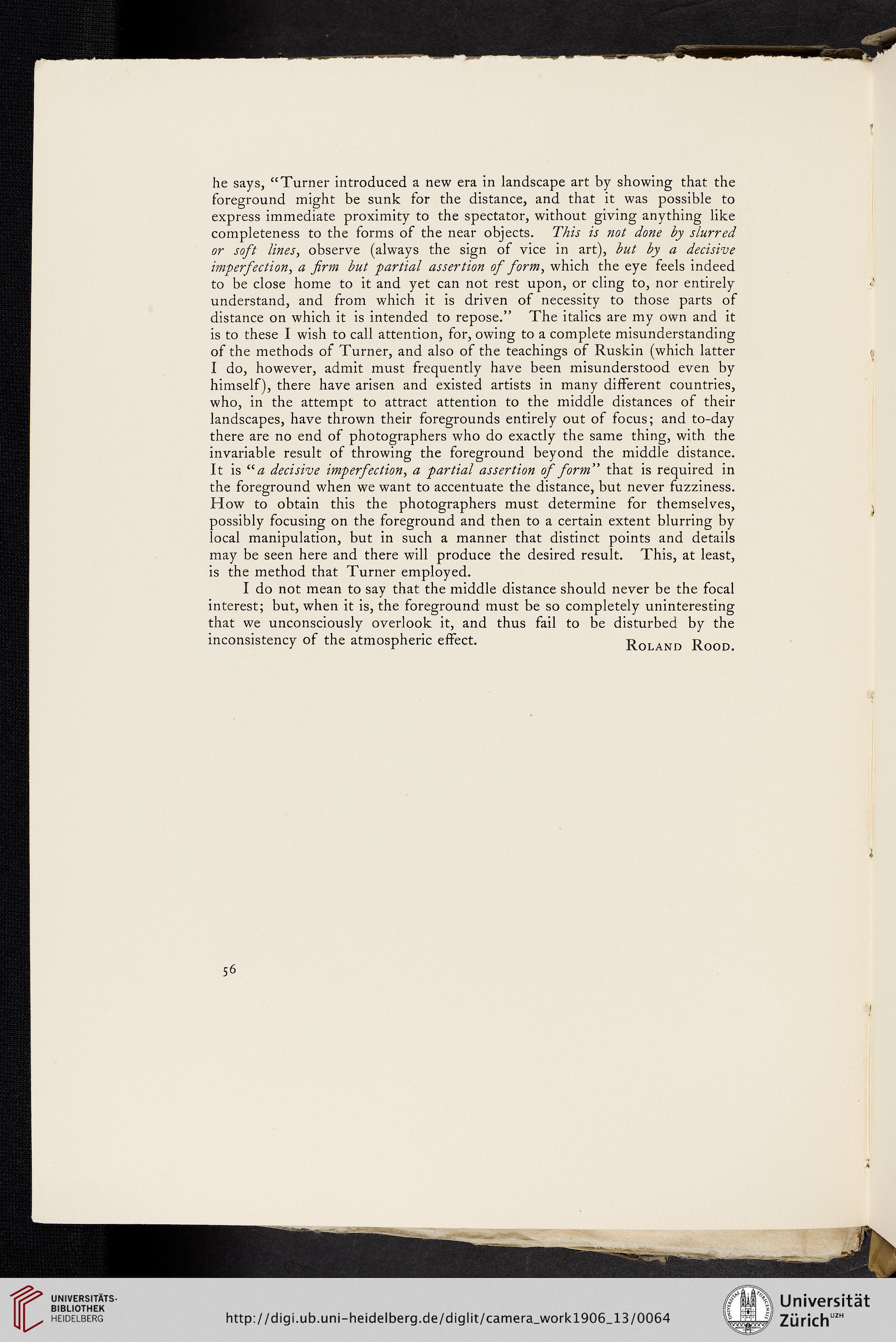Für diese Seite ist auch eine manuell angefertigte Transkription bzw. Edition verfügbar. Bitte wechseln Sie dafür zum Reiter "Transkription" oder "Edition".
he says, “Turner introduced a new era in landscape art by showing that the
foreground might be sunk for the distance, and that it was possible to
express immediate proximity to the spectator, without giving anything like
completeness to the forms of the near objects. This is not done by slurred
or soft lines, observe (always the sign of vice in art), but by a decisive
imperfection , a firm but partial assertion of form, which the eye feels indeed
to be close home to it and yet can not rest upon, or cling to, nor entirely
understand, and from which it is driven of necessity to those parts of
distance on which it is intended to repose." The italics are my own and it
is to these I wish to call attention, for, owing to a complete misunderstanding
of the methods of Turner, and also of the teachings of Ruskin (which latter
I do , however, admit must frequently have been misunderstood even by
himself), there have arisen and existed artists in many different countries,
who, in the attempt to attract attention to the middle distances of their
landscapes, have thrown their foregrounds entirely out of focus; and to-day
there are no end of photographers who do exactly the same thing, with the
invariable result of throwing the foreground beyond the middle distance.
It is “ a decisive imperfection, a partial assertion of form” that is required in
the foreground when we want to accentuate the distance, but never fuzziness.
How to obtain this the photographers must determine for themselves,
possibly focusing on the foreground and then to a certain extent blurring by
local manipulation, but in such a manner that distinct points and details
may be seen here and there will produce the desired result. This, at least,
is the method that Turner employed.
I do not mean to say that the middle distance should never be the focal
interest; but, when it is, the foreground must be so completely uninteresting
that we unconsciously overlook it, and thus fail to be disturbed by the
inconsistency of the atmospheric effect. Roland Rood .
56
foreground might be sunk for the distance, and that it was possible to
express immediate proximity to the spectator, without giving anything like
completeness to the forms of the near objects. This is not done by slurred
or soft lines, observe (always the sign of vice in art), but by a decisive
imperfection , a firm but partial assertion of form, which the eye feels indeed
to be close home to it and yet can not rest upon, or cling to, nor entirely
understand, and from which it is driven of necessity to those parts of
distance on which it is intended to repose." The italics are my own and it
is to these I wish to call attention, for, owing to a complete misunderstanding
of the methods of Turner, and also of the teachings of Ruskin (which latter
I do , however, admit must frequently have been misunderstood even by
himself), there have arisen and existed artists in many different countries,
who, in the attempt to attract attention to the middle distances of their
landscapes, have thrown their foregrounds entirely out of focus; and to-day
there are no end of photographers who do exactly the same thing, with the
invariable result of throwing the foreground beyond the middle distance.
It is “ a decisive imperfection, a partial assertion of form” that is required in
the foreground when we want to accentuate the distance, but never fuzziness.
How to obtain this the photographers must determine for themselves,
possibly focusing on the foreground and then to a certain extent blurring by
local manipulation, but in such a manner that distinct points and details
may be seen here and there will produce the desired result. This, at least,
is the method that Turner employed.
I do not mean to say that the middle distance should never be the focal
interest; but, when it is, the foreground must be so completely uninteresting
that we unconsciously overlook it, and thus fail to be disturbed by the
inconsistency of the atmospheric effect. Roland Rood .
56


